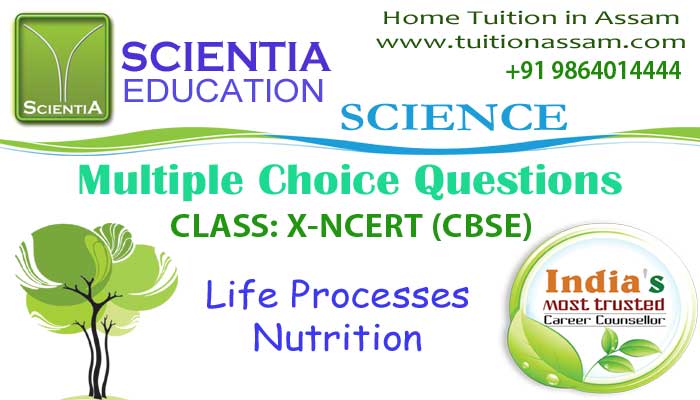
CLASS: X NCERT (CBSE)
BIOLOGY
Life Processes Nutrition
Question (1): Nutrition includes the study of _____________.
1. the organism’s food
2. process of digestion
3. the way an organism obtains food
4. all of the above
Ans: 4
Question (2): Autotrophic organisms include ____________.
1. green plants and sulphur bacteria
2. green plants and all the bacteria
3. bacteria and virus
4. bacteria and fungi
Ans: 1
Question (3): Organisms that synthesise their own food are called _________________.
1. green plants
2. sulphur bacteria
3. autotrophs
4. purple-sulphur bacteria
Ans: 3
Question (4): Amoeba feeds with the help of _______________.
1. tentacles
2. pseudopodia
3. food vacuole
4. none of the above
Ans: 2
Question (5): An example of higher plant parasite is __________.
1. Pythium
2. Phytophthora
3. Agaricus
4. Cuscuta
Ans: 4
Question (6): Example of chemosynthetic bacteria are _____________.
1. E. coli
2. sulphur bacteria
3. cyanobacteria
4. nitrobacter
Ans: 4
Question (7): An example of a fluid feeder is __________________.
1. aphid
2. hydra
3. amoeba
4. earthworm
Ans: 1
Question (8): In saprophytes, food is digested ______________.
1. within the cells
2. in the digestive tract
3. outside the cells
4. within the food vacuole
Ans: 3
Question (9): Parotid gland is a /an_______________.
1. gastric gland
2. intestinal gland
3. salivary gland
4. none of the above
Ans: 3
Question (10): Erepsin converts ________________.
1. proteins into amino acids
2. proteins into peptides
3. peptides into amino acids
4. none of the above
Ans: 3
Question (11): An enzyme that acts only in an acidic medium is ______.
1. pepsin
2. trypsin
3. rennin
4. amylase
Ans: 1
Question (12): A non-enzyme protein present in the saliva is _________.
1. heparin
2. mucin
3. ptyalin
4. none of the above
Ans: 2
Question (13): Coprophagy refers to feeding on ________________.
1. insects
2. dead matter
3. faeces
4. decomposing matter
Ans: 3
Question (14): Absorption is maximum in the small intestine because of ___________.
1. the presence of villi
2. its length
3. its thin walls
4. all the above
Ans: 4
Question (15): Photolysis is ______________.
1. the absorption of light by chlorophyll
2. the assimilation of carbon dioxide
3. the splitting of water
4. none of the above
Ans: 3
Question (16): The optimum level of carbon dioxide in the atmosphere is _________.
1. 0.3%
2. 0 .04%
3. 0 .1%
4. 0 .03%
Ans: 4
Question (17): Pyloric valve is present in the _____________.
1. heart
2. liver
3. stomach
4. intestine
Ans: 3
Question (18): Mastication is ______________.
1. digestion
2. absorption
3. assimilation
4. chewing
Ans: 4
Question (19): In the mouth the food is formed into __________.
1. chyme
2. chyle
3. bolus
4. pellets
Ans: 3
Question (20): An example of a herbivore is ___________.
1. amoeba
2. hydra
3. grasshopper
4. none of the above
Ans: 3
Question (21): Appendix is a part of _________.
1. ileum
2. duodenum
3. caecum
4. colon
Ans: 3
Question (22): Bile juice is secreted by ______________.
1. liver
2. pancreas
3. salivary gland
4. intestine
Ans: 1
Question (23): Bile juice is _______________.
1. alkaline
2. acidic
3. neutral
4. near acidic
Ans: 1
Question (24): The three portions of the small intestine, in the correct order, are _____________.
1. caecum, colon, rectum
2. ileum, duodenum, jejunum
3. colon, caecum, rectum
4. duodenum, jejunum, ileum
Ans: 4
Question (25): The enzyme that is secreted in an inactive form is _______.
1. lipase
2. trypsin
3. rennin
4. ptyalin
Ans: 2
Question (26): Exchange of gases in higher plants takes place through _____________.
1. lenticels
2. roots
3. stomata
4. stem
Ans: 3
Question (27): Insectivorous plants grow in soil deficient in _________.
1. calcium
2. phosphorus
3. nitrogen
4. water
Ans: 3
Question (28): Photosynthesis is _______________.
1. a catabolic reaction
2. an anabolic reaction
3. an energy releasing reaction
4. none of the above
Ans: 2
Question (29): The digestive juice that is almost neutral is ____________.
1. gastric juice
2. bile juice
3. pancreatic juice
4. none of the above
Ans: 3
Question (30): Haustoria of parasites are modified _____________.
1. roots
2. branches
3. leaves
4. none of the above
Ans: 1
Question (31): The molecules known as the energy currency of the cell are ________________.
1. NAD
2. NADP
3. ATP
4. ADP
Ans: 3
Question (32): The mode of nutrition in non-green plants is called ______________.
1. autotrophic
2. heterotrophic
3. holozoic
4. holophytic
Ans: 2
Question (33): Which of the following are chiefly digested in the stomach?
1. carbohydrates
2. proteins
3. fats
4. lipids
Ans: 2
Question (34): The reactants of photosynthesis reaction are carbon dioxide and _____________.
1. chlorophyll
2. sunlight
3. water
4. oxygen
Ans: 3
Question (35): Large intestine in man mainly carries out _____________.
1. digestion of fats
2. absorption
3. assimilation
4. digestion of carbohydrates
Ans: 2
Question (36): Mode of nutrition in green plants is called ______________.
1. heterotrophic
2. holozoic
3. holophytic
4. saprotrophic
Ans: 3
Question (37): The part of the digestive system where no digestion takes place is ______________.
1. mouth
2. oesophagus
3. ileum
4. stomach
Ans: 2
Question (38): The largest gland of the body is _____________.
1. parotid gland
2. liver
3. pancreas
4. submandibular gland
Ans: 2













